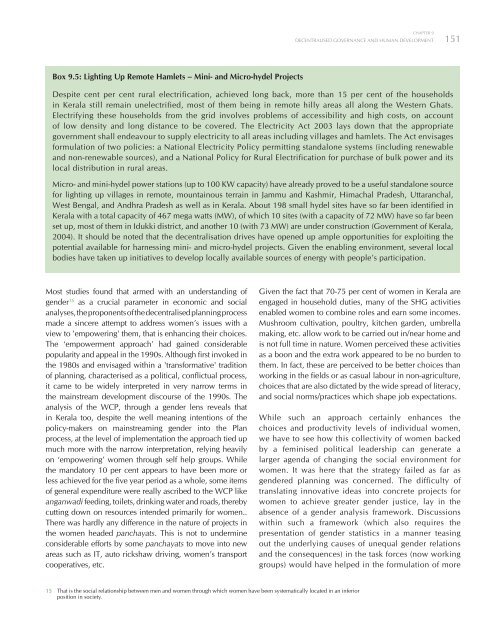Kerala 2005 - of Planning Commission
Kerala 2005 - of Planning Commission
Kerala 2005 - of Planning Commission
You also want an ePaper? Increase the reach of your titles
YUMPU automatically turns print PDFs into web optimized ePapers that Google loves.
CHAPTER 9<br />
DECENTRALISED GOVERNANCE AND HUMAN DEVELOPMENT<br />
151<br />
Box 9.5: Lighting Up Remote Hamlets – Mini- and Micro-hydel Projects<br />
Despite cent per cent rural electrification, achieved long back, more than 15 per cent <strong>of</strong> the households<br />
in <strong>Kerala</strong> still remain unelectrified, most <strong>of</strong> them being in remote hilly areas all along the Western Ghats.<br />
Electrifying these households from the grid involves problems <strong>of</strong> accessibility and high costs, on account<br />
<strong>of</strong> low density and long distance to be covered. The Electricity Act 2003 lays down that the appropriate<br />
government shall endeavour to supply electricity to all areas including villages and hamlets. The Act envisages<br />
formulation <strong>of</strong> two policies: a National Electricity Policy permitting standalone systems (including renewable<br />
and non-renewable sources), and a National Policy for Rural Electrification for purchase <strong>of</strong> bulk power and its<br />
local distribution in rural areas.<br />
Micro- and mini-hydel power stations (up to 100 KW capacity) have already proved to be a useful standalone source<br />
for lighting up villages in remote, mountainous terrain in Jammu and Kashmir, Himachal Pradesh, Uttaranchal,<br />
West Bengal, and Andhra Pradesh as well as in <strong>Kerala</strong>. About 198 small hydel sites have so far been identified in<br />
<strong>Kerala</strong> with a total capacity <strong>of</strong> 467 mega watts (MW), <strong>of</strong> which 10 sites (with a capacity <strong>of</strong> 72 MW) have so far been<br />
set up, most <strong>of</strong> them in Idukki district, and another 10 (with 73 MW) are under construction (Government <strong>of</strong> <strong>Kerala</strong>,<br />
2004). It should be noted that the decentralisation drives have opened up ample opportunities for exploiting the<br />
potential available for harnessing mini- and micro-hydel projects. Given the enabling environment, several local<br />
bodies have taken up initiatives to develop locally available sources <strong>of</strong> energy with people’s participation.<br />
Most studies found that armed with an understanding <strong>of</strong><br />
gender 15 as a crucial parameter in economic and social<br />
analyses, the proponents <strong>of</strong> the decentralised planning process<br />
made a sincere attempt to address women’s issues with a<br />
view to 'empowering' them, that is enhancing their choices.<br />
The ‘empowerment approach’ had gained considerable<br />
popularity and appeal in the 1990s. Although first invoked in<br />
the 1980s and envisaged within a 'transformative' tradition<br />
<strong>of</strong> planning, characterised as a political, conflictual process,<br />
it came to be widely interpreted in very narrow terms in<br />
the mainstream development discourse <strong>of</strong> the 1990s. The<br />
analysis <strong>of</strong> the WCP, through a gender lens reveals that<br />
in <strong>Kerala</strong> too, despite the well meaning intentions <strong>of</strong> the<br />
policy-makers on mainstreaming gender into the Plan<br />
process, at the level <strong>of</strong> implementation the approach tied up<br />
much more with the narrow interpretation, relying heavily<br />
on ‘empowering’ women through self help groups. While<br />
the mandatory 10 per cent appears to have been more or<br />
less achieved for the five year period as a whole, some items<br />
<strong>of</strong> general expenditure were really ascribed to the WCP like<br />
anganwadi feeding, toilets, drinking water and roads, thereby<br />
cutting down on resources intended primarily for women..<br />
There was hardly any difference in the nature <strong>of</strong> projects in<br />
the women headed panchayats. This is not to undermine<br />
considerable efforts by some panchayats to move into new<br />
areas such as IT, auto rickshaw driving, women’s transport<br />
cooperatives, etc.<br />
Given the fact that 70-75 per cent <strong>of</strong> women in <strong>Kerala</strong> are<br />
engaged in household duties, many <strong>of</strong> the SHG activities<br />
enabled women to combine roles and earn some incomes.<br />
Mushroom cultivation, poultry, kitchen garden, umbrella<br />
making, etc. allow work to be carried out in/near home and<br />
is not full time in nature. Women perceived these activities<br />
as a boon and the extra work appeared to be no burden to<br />
them. In fact, these are perceived to be better choices than<br />
working in the fields or as casual labour in non-agriculture,<br />
choices that are also dictated by the wide spread <strong>of</strong> literacy,<br />
and social norms/practices which shape job expectations.<br />
While such an approach certainly enhances the<br />
choices and productivity levels <strong>of</strong> individual women,<br />
we have to see how this collectivity <strong>of</strong> women backed<br />
by a feminised political leadership can generate a<br />
larger agenda <strong>of</strong> changing the social environment for<br />
women. It was here that the strategy failed as far as<br />
gendered planning was concerned. The difficulty <strong>of</strong><br />
translating innovative ideas into concrete projects for<br />
women to achieve greater gender justice, lay in the<br />
absence <strong>of</strong> a gender analysis framework. Discussions<br />
within such a framework (which also requires the<br />
presentation <strong>of</strong> gender statistics in a manner teasing<br />
out the underlying causes <strong>of</strong> unequal gender relations<br />
and the consequences) in the task forces (now working<br />
groups) would have helped in the formulation <strong>of</strong> more<br />
15 That is the social relationship between men and women through which women have been systematically located in an inferior<br />
position in society.

















